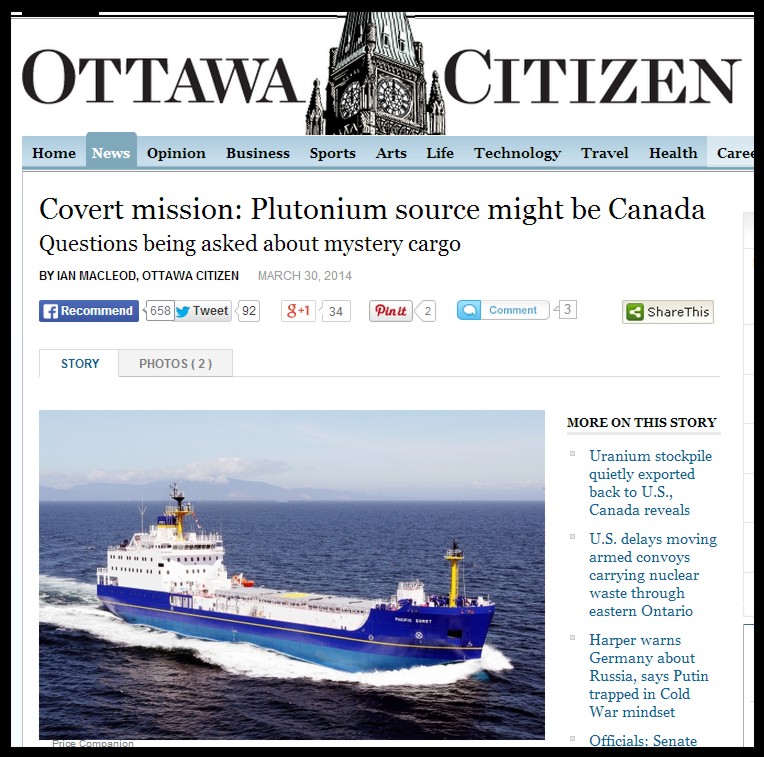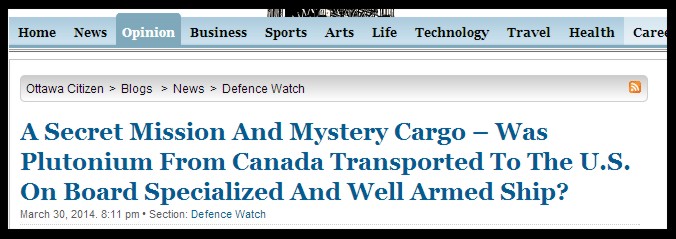|
The
Covert mission: Plutonium source might be Canada
by IAN
MACLEOD [Ottawa Citizen].
According to Tom Clements, a nuclear materials expert
and adviser to the South Carolina Chapter of the Sierra
Club, says without a firm “disposition pathway” for the
civilian MOX and separated plutonium arriving from
foreign nations, local residents fear the Savannah River
Site will be left “holding the plutonium bag. Ottawa
Citizen reported in March 30.
The nuclear fuel carrier Pacific Egret slipped into the
harbour at Charleston, South Carolina, on March 19 and
unloaded a top-secret cargo at the port’s Naval Weapons
Station.
Fitted with naval guns, cannons and extensive hidden
means of repelling a terrorist assault, the
three-year-old British vessel was purpose-built to
transport plutonium, highly enriched uranium (HEU) and
mixed-oxide (MOX) nuclear fuel on the high seas.
Its previous publicly reported position had been exiting
the Mediterranean at the Strait of Gibraltar almost two
weeks earlier on March 7, carrying a delicate nuclear
cargo loaded at the La Spezia naval base in northern
Italy.
As the vessel entered the North Atlantic that day, its
tracking image vanished from an online marine traffic
monitoring system. The ship the size of a football field
became all but invisible to unauthorized eyes.
Questions are now being raised about whether the
sensitive cargo included recycled plutonium that
originated here in Canada.
The clandestine business of transporting shiploads of
fissile nuclear materials between nations rarely comes
into public view. An eight-kilogram piece of
plutonium-239 the size of a grapefruit could obliterate
much of Ottawa in seconds — as it did to Nagasaki in
August 1945. It’s aptly named after the ancient Greek
god of the underworld.
Five days after the Pacific Egret docked in Charleston,
58 world leaders, Prime Minister Stephen Harper among
them, gathered in The Hague for this past week’s 2014
Nuclear Security Summit.
The purpose of the biennial meeting is to secure the
vast global inventory of vulnerable nuclear materials.
Restricting plutonium was this year’s unofficial theme.
And it wasn’t long before the reason for the Pacific
Egret’s covert missions surfaced.
Italy announced the successful removal to the U.S. of 17
kilograms of plutonium and HEU to the Department of
Energy’s Savannah River Site nuclear waste complex near
Aiken, S.C., a two-hour drive from Charleston.
A similar statement followed from Belgium, where the
Pacific Egret loaded plutonium and HEU destined for
Savannah in late January. Japan, another of the ship’s
regular ports of call, said it would cede control to the
U.S. of more than 300 kilograms of plutonium and 200 kg
of HEU, enough to build about 40 nuclear warheads.
It’s believed that separated plutonium and HEU have been
totally removed from 12 countries since U.S. President
Barack Obama initiated the summits in 2010. In all,
almost 3,000 kilograms of weapons-grade fissile
materials have been removed or disposed of from 27
countries.
Yet there remains an estimated 490 tonnes of plutonium
around the world for military and civilian use, plus
approximately 1,250 tonnes of HEU, enough for more than
55,000 basic atomic bombs.
As a non-weapons state, Canada does not manufacturer HEU
or reprocess spent reactor fuel to extract and recycle
plutonium — a byproduct of nuclear fission. (In a
conventional nuclear reactor, one kilogram of recycled
plutonium-239 can produce sufficient heat to generate
nearly 10 million kilowatt-hours of electricity. The
downside is the risk of theft and nuclear proliferation.)
Instead, Canada imports small amounts of HEU from the
U.S. as fuel for some research reactors — CANDU power
reactors run on natural uranium — and for medical
isotope production.
Read more here:
www.ottawacitizen.com/news/Covert+mission

On board of the "cargo" there would be "approximately"
20 kilograms of hazardous radioactive materials, highly
enriched uranium and plutonium, coming from the Sogin
nuclear deposits and loaded in the Military port of La
Spezia.
Sources from newspapers and TV-Media here:
✔
http://www.tgcom24.mediaset.it/cronaca/2014/notizia/la-spezia-svelato-il-giallo-della-nave-era-carica-di-uranio-e-plutonio_2035524.shtml
(private berlusconi's TV...)
✔ http://www.ligurianotizie.it/la-nave-con-materiale-radiottativo-ricompare-port-wentworth/2014/03/25/121114/
[Regional Press].

So the "Secret
Mission And Mystery Cargo"... with previous publicly
reported position had been exiting the Mediterranean at
the Strait of Gibraltar almost two weeks earlier on
March 7, carrying a delicate nuclear cargo loaded at the
La Spezia naval base in northern Italy. According to
Italian press another reported position was near the
coast of South Carolina directed to Port Wentworth. Then
the only source that we have is the Ottawa Citizen that
confirmed position in the United States where the
nuclear fuel carrier Pacific Egret slipped into the
harbour at Charleston, South Carolina, on March 19 and
unloaded a top-secret cargo at the port’s Naval Weapons
Station with the revelation of a new direction: Canada.
And... as the vessel entered the North Atlantic that day,
its tracking image vanished from an online marine
traffic monitoring system. The ship the size of a
football field became all but invisible to unauthorized
eyes.
 |